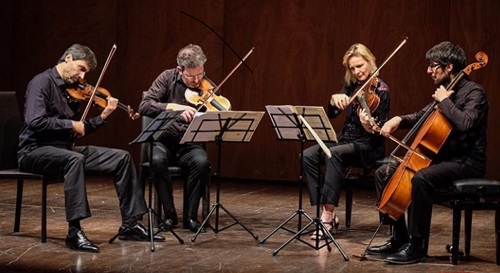 Italy Shostakovich: Quartetto Prometeo (Giulio Rovighi, Aldo Campagnari [violins], Danusha Waskiewicz [viola], Francesco Dillon [cello]). Teatro Argentina, Rome, 20.1.2022. (GP)
Italy Shostakovich: Quartetto Prometeo (Giulio Rovighi, Aldo Campagnari [violins], Danusha Waskiewicz [viola], Francesco Dillon [cello]). Teatro Argentina, Rome, 20.1.2022. (GP)

Shostakovich – Quartet No.1 in C major, Op.49; Quartet No.2 in A major, Op.68; Quartet No.3 in F major, Op.73
Stendhal called the Teatro Argentina ‘the most beautiful in the world’. It was there the Roman Philharmonic Academy, in the season of its centenary, began its chamber music series with an exceptional proposal: the complete fifteen string quartets by Dmitry Shostakovich, performed, in concerts over three years, by the Prometeo Quartet (Quartetto Prometeo).
The Prometeo Quartet was the winner of the 50th edition of the Prague Spring International Music Competition in 1998. It was awarded the Bärenreiter Special Prize for best performance faithful to the original text of Mozart’s K590 Quartet, the City of Prague Prize for Best Quartet and the Pro Harmonia Mundi Prize. In 1998, it was elected resident complex of the Britten Pears Academy in Aldeburgh, in 1999, it received the Thomas Infeld Prize from the Internationale Sommer Akademie Prague-Wien-Budapest for its ‘extraordinary interpretative skills for a composition of the chamber repertoire for strings’, and was second at the Concours International de Quatuors in Bordeaux. In 2000, it was awarded the Bärenreiter Special Prize again at the ARD Competition in Munich. In 2012, it received the “Silver Lion” at the Venice Music Biennale. It is an ensemble of great international fame, and this is also why the Argentina theatre had much larger audience than usual in this pandemic period.
The fifteen string quartets constitute a valuable part of Shostakovich’s spiritual legacy. He considered it ‘profoundly wrong to believe that in chamber music the dimension of ideas and emotions is less important than in other genres’. To the ensemble of the four string instruments, he entrusted his most intimate feelings. Shostakovich himself recounted how his first quartet was born in the spring of 1938: ‘After the Fifth Symphony, I did almost nothing. I wrote only one quartet, in four short movements. I started without any particular ideas. I thought nothing would come out. Because the quartet is one of the most difficult musical genres. I wrote the first page as a kind of exercise in the quartet form, with no intention of completing or publishing it … I was, then, passionate about the work and I started writing it very quickly. We must not look for a particular depth in my first quartet; it is joyful, cheerful, lyrical. I would call it a ‘springtime composition.’
The Prometeo Quartet rendered this ‘joyful, cheerful, lyrical’ aspect very well, right from the beginning in the first (Moderato) movement. In the second movement (also Moderato), the initial solo of the viola stood out, as well as a popular theme performed by the whole ensemble. In the Allegro, the Quartet emphasized scherzo.
The program notes recall that Shostakovich dedicated the second quartet to a well-known composer who was also his dear friend, Vissarion Šebalin (1902-1963). On 6th September 1944, in the middle of the war, Shostakovich wrote to him: ‘Dear Ronja, a few days ago, I remembered that exactly twenty years have passed since we met … Today I finished the second movement of a quartet, which I had begun to compose […]. Without a pause, I started the third movement (the penultimate). I want to dedicate the quartet to you to celebrate the anniversary” (of our friendship)’. The quartet is a suite, consisting of four movements entitled: ‘overture’, ‘recitative’, ‘romance and waltz’, ‘theme and variations’. In the performance by the Prometeo Quartet, the first movement has a national and Slavic character, energetic, of healthy vitality, while the second, in the rhythm of a mazurka, was more lyrical. The solo of the first violin is a soothing romantic melody. The third movement develops a fascinating waltz. In the fourth and last movement, the theme enters, exposed by the viola, into a long melody of sustained breath that transforms rhythmically, growing in dynamics and attaining power and solemnity.
In the third quartet, Shostakovich expresses the tragic aspect of life at the highest level. It comprises five movements. The initial Allegretto is based on two themes, the first graceful and carefree, the second more serene. In the following Moderato con moto, the Prometeo Quartet revealed the two very contrasting images which appear: one authoritarian, nervously discontinuous, and the other magically sparkling. The Allegro ma non troppo is a wild dance – with a theme of deliberate vulgarity by the viola solo. The next Adagio is an impressive requiem. In the concluding Moderato, the initial theme is gradually replaced by a dancing rhythm. At the climax, the theme of the passacaglia of the fourth movement returns. Ultimately, the theme of the ‘finale’ dissolved, rising higher and higher.
There was much applause and the evening was a great success. The second concert of this cycle will be on 5th May.
Giuseppe Pennisi